SEO
Google Search Results is Shrinking!
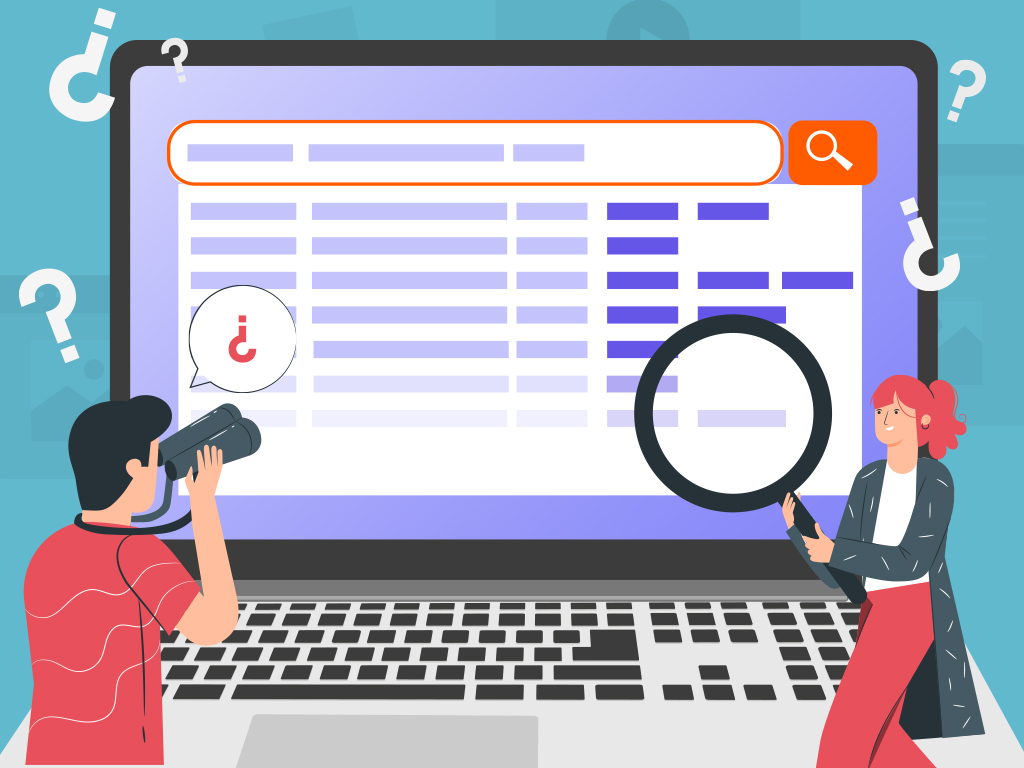
Seeing rankings go from NOT IN TOP 100 to the first page of Google is what we live for as SEO specialists. Thank you rank tracking software!
But a few days go by and you noticed that your website’s organic traffic is still low and it got you thinking – “my website is ranking on the first page of Google but, why am I not gaining any clicks and visitors to my website?”
Only to find out that your website is not even on the first page!
WHAT?! (As we all know, no one checks the second page of search results) This is because some search queries on Google will result in showing only 9 or even worse, only 7 search results.
Wait, you didn’t know that?
Yes, this has been happening since April 2012 and you may not be aware of this up to today. Because in the past, it wouldn’t happen so often but now search results pages are using this as the staple. 7 – 9 results are far more common today than ever before.
Google Search Results: Shrinking Number of SERPs
If you try searching on Google right now, there is a good percentage of results pages that only show 7 to 9 results on the first page instead of the usual 10. This has been first noticed by Dr. Pete in April 2012 which he wrote on his SEOmoz blog
Here’s the graph from the first time he noticed it:

This just shows the rise of first-page search results that show less than 10 listings. From 2% it drastically increased to 18% within two days.
Another follow-up study was done by Larry Kim, in support of what Dr. Pete discovered. Based on his investigation, he noticed that:
- 100% of the organic search results that contained sitelinks also had other SERPs features with 7 or fewer organic listings.
- 100% of the organic search results that did not contain sitelinks had the usual 10 organic listings.
But the data you’re showing is from 10 years ago, is it relevant until now?
YES!
As Google never looked back and instead implemented it into more of its search results.
‘7 is the New 10!’
Gone are the days when you will see precisely 10 search results on the first page of every Google search result. This has been the case for a lot of search queries for branded keywords ever since that change in April 2012.
And now there’s a new trend on Google’s search results, this is where it only shows 9, 8, and worst 7 links even for non-branded, generic keywords!
A thing I noticed is that in many search engine results pages (SERPs) nowadays is a rising amount of SERPs Features on every search query. And this has impacted every organic result as most of these SERPs Features have taken over and knocked down some of the coveted organic ‘blue links’ down to the second page.
Another thing that changed the world of ‘search’ is that it functions more like a ‘search feed’ rather than a ‘search listing’. As these two things may sound the same but they are not. A ‘feed’ is more like the idea of social networking platforms, where the content shown is intended to keep users scrolling with endless results. Wherein the concept of a ‘list’ before is specific and straightforward Top 10 results and that’s it.

This certainly indicates how the digital world has evolved, at which point users are conditioned to scroll endlessly. The domination of social networking platforms in user engagement and retention has made search engines adapt to it. At the end of the day, both search and these social networking platforms are advertising-based industries that earn through ad impressions.
‘Finding 10’ – Nowhere to be found!
Try searching on Google on a desktop device right now, and I bet you that most of your search results will show fewer than 10.
Here are a few examples you can try searching:
- Advertising: 9 results
- Glamorous Camping: 8 results
- Food Delivery Manila: 7 results
- Kid-friendly Places in Makati: 9 results
Those are just some of the results I got while testing multiple queries on a desktop in incognito and normal mode of Chrome. As you can see I tried to search using short-head terms and longtail terms, and most of the results do not show the 10th listing in the SERPs.
But also keep in mind that these SERP results and layout may differ in every country so the number of snippets on the first page can change.
Organic Results V.S. SERP Features
As I got curious about SERP Features (events, top stories, and knowledge panels) and how it affects Google search results, I tried to look for other people’s analysis regarding this. I found a very interesting case study done by Kevin Indig, an SEO practitioner.

And the image below is the data Kevin gathered with his investigation into knowing the relationship between organic results and SERP Features.
Note: “1” means the SERP Feature appeared above the first organic results; “5” means it appeared before the fifth organic results, etc

The data above also supports the assumption that SERP Features do affect the number of organic listings in Google search results – the more SERP Features appear leads to less number of organic results.
More data and research is needed to fully establish the relationship between organic results and SERP Features. But the research above shows a pattern in its results and this could help jumpstart a full thesis on this topic.
How does this affect SEO?
These changes will profoundly affect SEO. As it is already visible and taking effect on Google search results – however, we do not have enough data regarding the shift of search engines from showing the classic ‘lists’ to user engagement and retention-focused ‘feeds.’
So this is very alarming, especially for SEO companies and practitioners that rely on software in tracking the rankings of their clients. Rank-tracking software does not necessarily display if your website is on the first or later pages of results – so checking directly will be the only logical solution.
One of our partners, SEranking, is working on a solution to show TRUE first-page rankings as we write this blog. You might want to check them out!
Yes, we are still looking at this from an outsider’s view through a blurry lens. But some things became clear:
- Go for at least 7, not 10!
– Being in the Top 10 means a lot less now compared to a decade ago! You should be targeting to be at least in the Top 7 to make your website relevant. Because even the bottom 3-5 results do not matter anymore if a more eminent SERP Feature hovers above them. - Organic Real Estate is Shrinking!
– Google adding a handful of SERP Features takes up the supposed spots for organic listings in the search results. This lowers the opportunities for you to increase the organic traffic of your website. - ‘Search Feed’ over ‘Search Lists’
– Search results are much more crowded! The diversity of search results is shrinking. As Google is prioritizing some of its SERPs spots for different types of sites such as affiliates, brands, and marketplaces. But we cannot blame Google for this, as those links generate profit for them – after all, Google is still a business. And all businesses need to grow their revenues year on year.
Key Takeaway
From 10 to 9 to 8 to 7 results, this goes to show how much search results pages have changed over the years. As SEO practitioners we should adapt to this, from strategizing to getting into that ‘list’ to embracing the new format of endless ‘feed’.
We have all known since day one that SEO is ever-changing, but for a long time, we believed that getting into the Top 10 would deliver at least some traffic. And I say that thinking is now outdated, that is why you need to have a very capable and competitive SEO service provider that won’t just help you reach the top but will make sure to maintain your position.
What do you think about the shrinking organic results page? Let us know your thoughts in the comments section below!
SEO
brightonSEO Live Blog
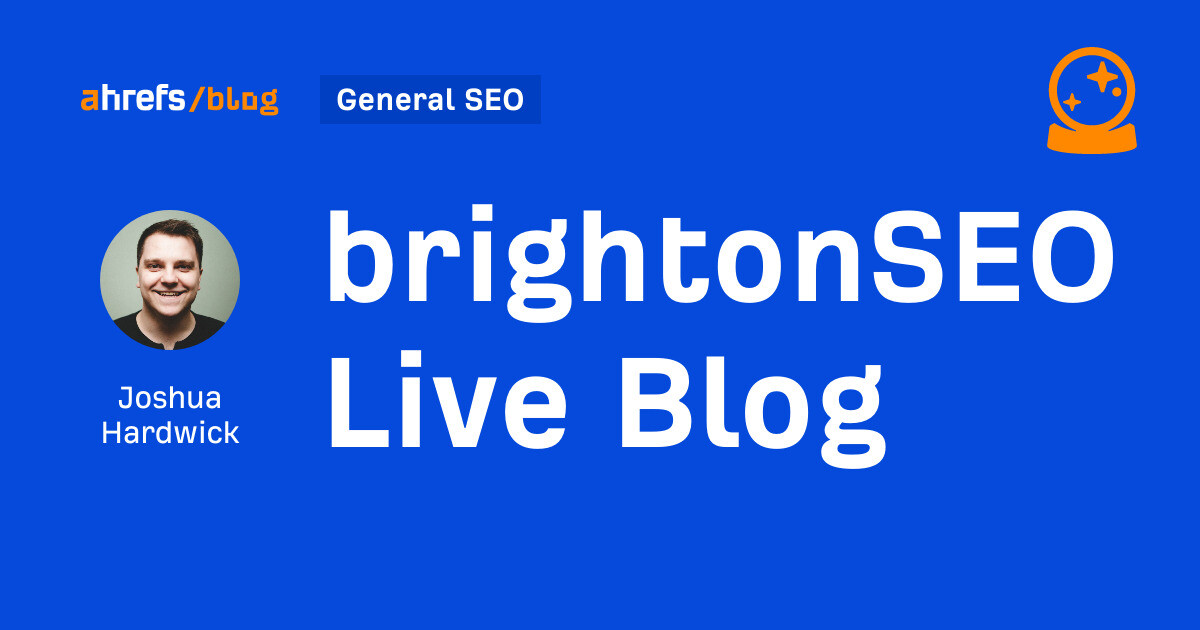
Hello everyone. It’s April again, so I’m back in Brighton for another two days of Being the introvert I am, my idea of fun isn’t hanging around our booth all day explaining we’ve run out of t-shirts (seriously, you need to be fast if you want swag!). So I decided to do something useful and live-blog the event instead.
Follow below for talk takeaways and (very) mildly humorous commentary. sun, sea, and SEO!
SEO
Google Further Postpones Third-Party Cookie Deprecation In Chrome

Google has again delayed its plan to phase out third-party cookies in the Chrome web browser. The latest postponement comes after ongoing challenges in reconciling feedback from industry stakeholders and regulators.
The announcement was made in Google and the UK’s Competition and Markets Authority (CMA) joint quarterly report on the Privacy Sandbox initiative, scheduled for release on April 26.
Chrome’s Third-Party Cookie Phaseout Pushed To 2025
Google states it “will not complete third-party cookie deprecation during the second half of Q4” this year as planned.
Instead, the tech giant aims to begin deprecating third-party cookies in Chrome “starting early next year,” assuming an agreement can be reached with the CMA and the UK’s Information Commissioner’s Office (ICO).
The statement reads:
“We recognize that there are ongoing challenges related to reconciling divergent feedback from the industry, regulators and developers, and will continue to engage closely with the entire ecosystem. It’s also critical that the CMA has sufficient time to review all evidence, including results from industry tests, which the CMA has asked market participants to provide by the end of June.”
Continued Engagement With Regulators
Google reiterated its commitment to “engaging closely with the CMA and ICO” throughout the process and hopes to conclude discussions this year.
This marks the third delay to Google’s plan to deprecate third-party cookies, initially aiming for a Q3 2023 phaseout before pushing it back to late 2024.
The postponements reflect the challenges in transitioning away from cross-site user tracking while balancing privacy and advertiser interests.
Transition Period & Impact
In January, Chrome began restricting third-party cookie access for 1% of users globally. This percentage was expected to gradually increase until 100% of users were covered by Q3 2024.
However, the latest delay gives websites and services more time to migrate away from third-party cookie dependencies through Google’s limited “deprecation trials” program.
The trials offer temporary cookie access extensions until December 27, 2024, for non-advertising use cases that can demonstrate direct user impact and functional breakage.
While easing the transition, the trials have strict eligibility rules. Advertising-related services are ineligible, and origins matching known ad-related domains are rejected.
Google states the program aims to address functional issues rather than relieve general data collection inconveniences.
Publisher & Advertiser Implications
The repeated delays highlight the potential disruption for digital publishers and advertisers relying on third-party cookie tracking.
Industry groups have raised concerns that restricting cross-site tracking could push websites toward more opaque privacy-invasive practices.
However, privacy advocates view the phaseout as crucial in preventing covert user profiling across the web.
With the latest postponement, all parties have more time to prepare for the eventual loss of third-party cookies and adopt Google’s proposed Privacy Sandbox APIs as replacements.
Featured Image: Novikov Aleksey/Shutterstock
SEO
How To Write ChatGPT Prompts To Get The Best Results

ChatGPT is a game changer in the field of SEO. This powerful language model can generate human-like content, making it an invaluable tool for SEO professionals.
However, the prompts you provide largely determine the quality of the output.
To unlock the full potential of ChatGPT and create content that resonates with your audience and search engines, writing effective prompts is crucial.
In this comprehensive guide, we’ll explore the art of writing prompts for ChatGPT, covering everything from basic techniques to advanced strategies for layering prompts and generating high-quality, SEO-friendly content.
Writing Prompts For ChatGPT
What Is A ChatGPT Prompt?
A ChatGPT prompt is an instruction or discussion topic a user provides for the ChatGPT AI model to respond to.
The prompt can be a question, statement, or any other stimulus to spark creativity, reflection, or engagement.
Users can use the prompt to generate ideas, share their thoughts, or start a conversation.
ChatGPT prompts are designed to be open-ended and can be customized based on the user’s preferences and interests.
How To Write Prompts For ChatGPT
Start by giving ChatGPT a writing prompt, such as, “Write a short story about a person who discovers they have a superpower.”
ChatGPT will then generate a response based on your prompt. Depending on the prompt’s complexity and the level of detail you requested, the answer may be a few sentences or several paragraphs long.
Use the ChatGPT-generated response as a starting point for your writing. You can take the ideas and concepts presented in the answer and expand upon them, adding your own unique spin to the story.
If you want to generate additional ideas, try asking ChatGPT follow-up questions related to your original prompt.
For example, you could ask, “What challenges might the person face in exploring their newfound superpower?” Or, “How might the person’s relationships with others be affected by their superpower?”
Remember that ChatGPT’s answers are generated by artificial intelligence and may not always be perfect or exactly what you want.
However, they can still be a great source of inspiration and help you start writing.
Must-Have GPTs Assistant
I recommend installing the WebBrowser Assistant created by the OpenAI Team. This tool allows you to add relevant Bing results to your ChatGPT prompts.
This assistant adds the first web results to your ChatGPT prompts for more accurate and up-to-date conversations.
It is very easy to install in only two clicks. (Click on Start Chat.)
For example, if I ask, “Who is Vincent Terrasi?,” ChatGPT has no answer.
With WebBrower Assistant, the assistant creates a new prompt with the first Bing results, and now ChatGPT knows who Vincent Terrasi is.
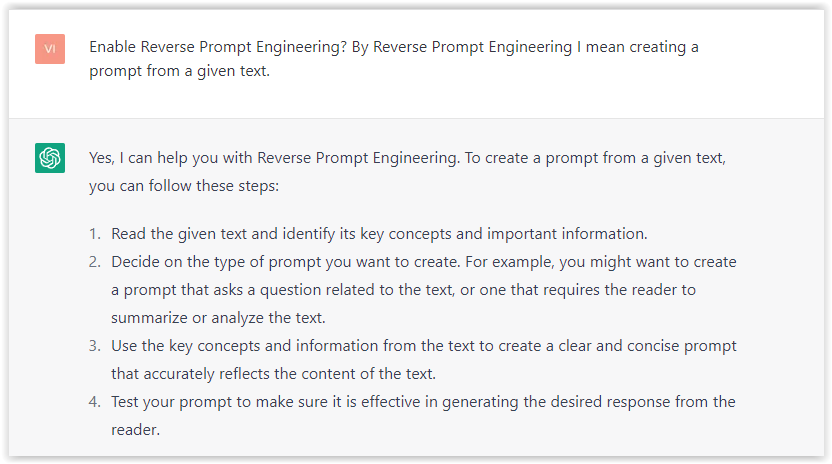 Screenshot from ChatGPT, March 2023
Screenshot from ChatGPT, March 2023You can test other GPT assistants available in the GPTs search engine if you want to use Google results.
Master Reverse Prompt Engineering
ChatGPT can be an excellent tool for reverse engineering prompts because it generates natural and engaging responses to any given input.
By analyzing the prompts generated by ChatGPT, it is possible to gain insight into the model’s underlying thought processes and decision-making strategies.
One key benefit of using ChatGPT to reverse engineer prompts is that the model is highly transparent in its decision-making.
This means that the reasoning and logic behind each response can be traced, making it easier to understand how the model arrives at its conclusions.
Once you’ve done this a few times for different types of content, you’ll gain insight into crafting more effective prompts.
Prepare Your ChatGPT For Generating Prompts
First, activate the reverse prompt engineering.
- Type the following prompt: “Enable Reverse Prompt Engineering? By Reverse Prompt Engineering I mean creating a prompt from a given text.”
 Screenshot from ChatGPT, March 2023
Screenshot from ChatGPT, March 2023ChatGPT is now ready to generate your prompt. You can test the product description in a new chatbot session and evaluate the generated prompt.
- Type: “Create a very technical reverse prompt engineering template for a product description about iPhone 11.”
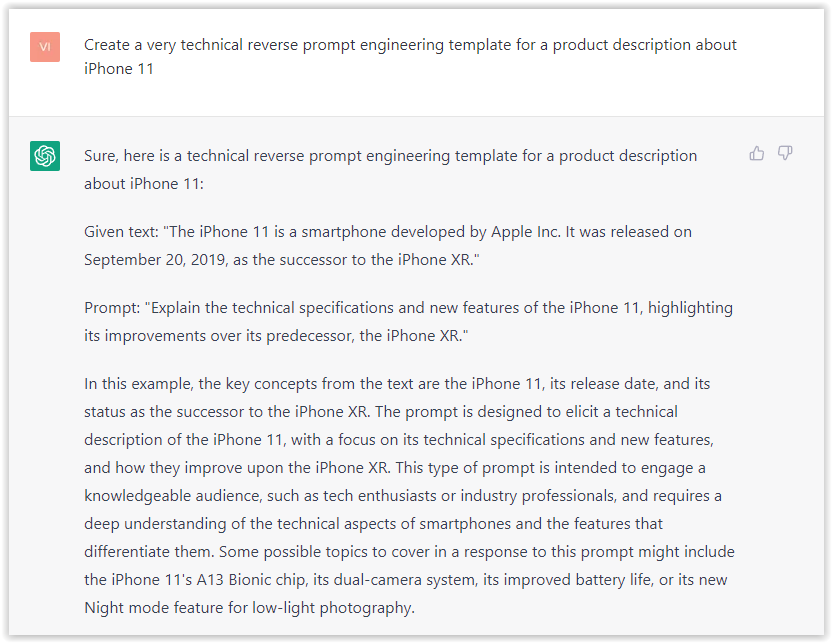 Screenshot from ChatGPT, March 2023
Screenshot from ChatGPT, March 2023The result is amazing. You can test with a full text that you want to reproduce. Here is an example of a prompt for selling a Kindle on Amazon.
- Type: “Reverse Prompt engineer the following {product), capture the writing style and the length of the text :
product =”
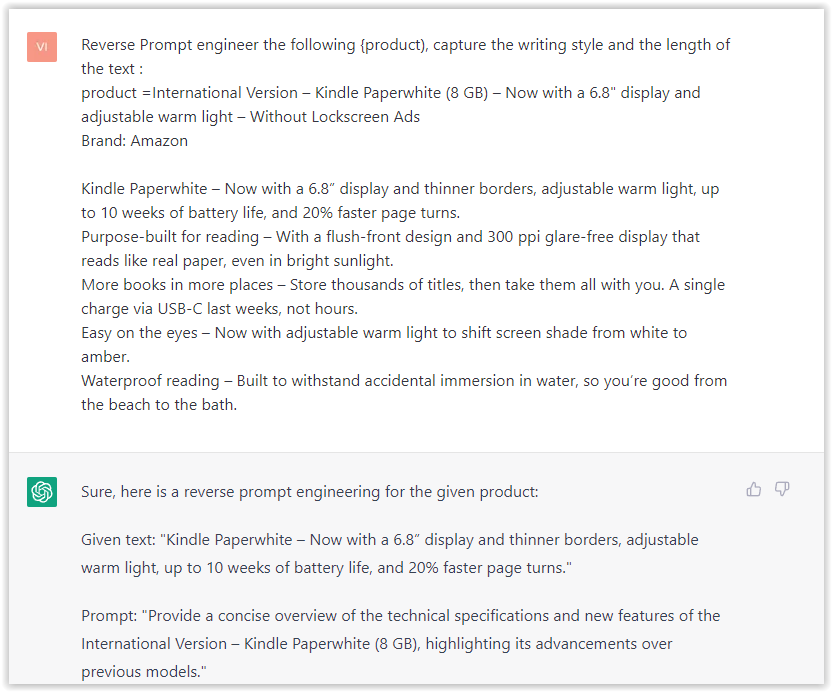 Screenshot from ChatGPT, March 2023
Screenshot from ChatGPT, March 2023I tested it on an SEJ blog post. Enjoy the analysis – it is excellent.
- Type: “Reverse Prompt engineer the following {text}, capture the tone and writing style of the {text} to include in the prompt :
text = all text coming from https://www.searchenginejournal.com/google-bard-training-data/478941/”
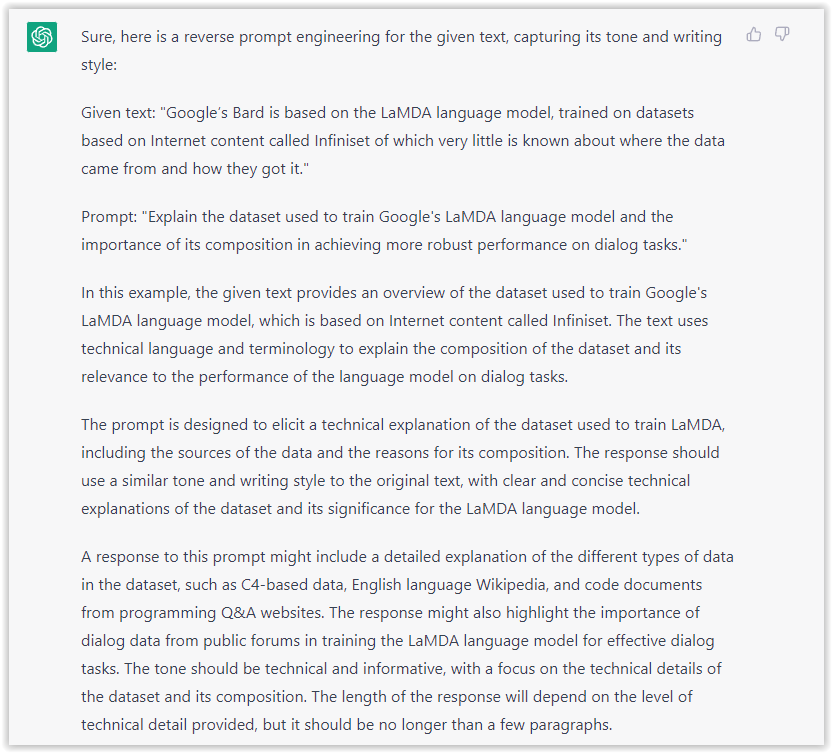 Screenshot from ChatGPT, March 2023
Screenshot from ChatGPT, March 2023But be careful not to use ChatGPT to generate your texts. It is just a personal assistant.
Go Deeper
Prompts and examples for SEO:
- Keyword research and content ideas prompt: “Provide a list of 20 long-tail keyword ideas related to ‘local SEO strategies’ along with brief content topic descriptions for each keyword.”
- Optimizing content for featured snippets prompt: “Write a 40-50 word paragraph optimized for the query ‘what is the featured snippet in Google search’ that could potentially earn the featured snippet.”
- Creating meta descriptions prompt: “Draft a compelling meta description for the following blog post title: ’10 Technical SEO Factors You Can’t Ignore in 2024′.”
Important Considerations:
- Always Fact-Check: While ChatGPT can be a helpful tool, it’s crucial to remember that it may generate inaccurate or fabricated information. Always verify any facts, statistics, or quotes generated by ChatGPT before incorporating them into your content.
- Maintain Control and Creativity: Use ChatGPT as a tool to assist your writing, not replace it. Don’t rely on it to do your thinking or create content from scratch. Your unique perspective and creativity are essential for producing high-quality, engaging content.
- Iteration is Key: Refine and revise the outputs generated by ChatGPT to ensure they align with your voice, style, and intended message.
Additional Prompts for Rewording and SEO:
– Rewrite this sentence to be more concise and impactful.
– Suggest alternative phrasing for this section to improve clarity.
– Identify opportunities to incorporate relevant internal and external links.
– Analyze the keyword density and suggest improvements for better SEO.
Remember, while ChatGPT can be a valuable tool, it’s essential to use it responsibly and maintain control over your content creation process.
Experiment And Refine Your Prompting Techniques
Writing effective prompts for ChatGPT is an essential skill for any SEO professional who wants to harness the power of AI-generated content.
Hopefully, the insights and examples shared in this article can inspire you and help guide you to crafting stronger prompts that yield high-quality content.
Remember to experiment with layering prompts, iterating on the output, and continually refining your prompting techniques.
This will help you stay ahead of the curve in the ever-changing world of SEO.
More resources:
Featured Image: Tapati Rinchumrus/Shutterstock
-

 PPC6 days ago
PPC6 days ago19 Best SEO Tools in 2024 (For Every Use Case)
-

 MARKETING7 days ago
MARKETING7 days agoEcommerce evolution: Blurring the lines between B2B and B2C
-
SEARCHENGINES5 days ago
Daily Search Forum Recap: April 19, 2024
-
SEARCHENGINES6 days ago
Daily Search Forum Recap: April 18, 2024
-

 WORDPRESS6 days ago
WORDPRESS6 days agoHow to Make $5000 of Passive Income Every Month in WordPress
-

 SEO7 days ago
SEO7 days ago2024 WordPress Vulnerability Report Shows Errors Sites Keep Making
-

 WORDPRESS7 days ago
WORDPRESS7 days ago10 Amazing WordPress Design Resouces – WordPress.com News
-

 SEO6 days ago
SEO6 days ago25 WordPress Alternatives Best For SEO
















You must be logged in to post a comment Login